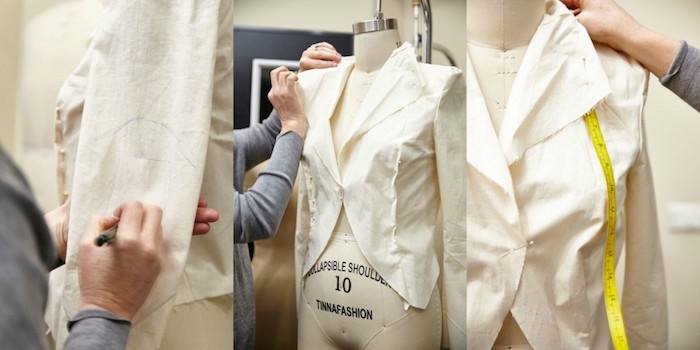What is a Toile?

There are many tricks of the trade within any industry. Certainly, within the fashion industry, one such trick is a toile. But what is it, exactly?
A toile is a word, derived from the French language, which describes a mock-up of your design. It is an early version of a garment, made of a cheaper, but similar fabric, to test and perfect the design. You can see how important this is to the industry, and also you, as the designer. It is in this toile that a designer can see if the garment is going to sing or sink. It is a necessary step and will assist in avoiding wasting money on sampling that will otherwise fail. I like to call it a quick and dirty version of your design.
When it comes to a toile, it is essential to use a fabric that is similar to the one you will use for your garments. If your design is made from a heavy and stiff fabric, then find something cheap and similar to this. If you’re going for a drapey, slinky and lightweight feel, then yes, do the same: find something close to this, but much cheaper and use for your toile.
In addition to being a similar weight and feel to your actual fabric, the fabric for a toile should be light in colour, so that you can use tailor’s chalk to mark out where changes need to be made. Here is where you get to test the design lines, and the fit of the garment. You can make markings on the toile and see if a lower V neckline will suit better than the round neck that you initially sketched. The toile will guide you to add darts, or lengthen the hemline, or if cap sleeves will fit better than a three-quarter sleeve.
The toile is your important chance to play with your design.
Once you’ve made the changes to the toile, then translate them back to your pattern. If you’ve had to cinch in areas on the toile where there was too much fabric, or if you’ve had to loosen where the toile showed pulling and stretching, translate these into your pattern. You might even choose to make a second toile if you’ve made a lot of changes.
We prefer to start with a toile. There is nothing worse than making a garment up with topstitching, pockets, overlocking and lining only to find out the shape is not right. It really is a waste of money. A toile costs approx half the cost of a sample if not less. Therefore this is valuable money wasted. I much prefer that we get the shape, length and placement of key measurements right first before creating the final garment.
Another option is the make the toile in the final sample fabric but only make it to a toile standard. We call this a first fit sample. What this means is that we use the fabric but do not waste time and money on overlocking seams, sewing hems, sewing button holes adding linings and facings. This can show you how the fabric will react but won’t waste precious funds on something that needs changing later on. We can cut this so it can be finished off after to a final sample finish.
It may seem like this is wasting time and money, but a toile is the perfect prototype for your design. We understand that you’re excited to get your designs created and that you are keen to launch, but a toile will save time and money in the long run. The main thing to be aware of is that you will need to use some imagination as the colour and fabric will not look like your final sample. This is hard for some people to do. I believe it is an essential part of being a designer so imagine. You will be able to test the fit, the length and other important elements of design in a toile so that when you see the final garment the basic elements will be correct. I always say that if it looks good in a toile then you can be sure that it will be a winner in final fabric.
That’s because we’ve seen failures in the industry. At Sample Room, we know that as gorgeous as your sketches are, sometimes it is sad to say, they don’t always translate to a gorgeous garment; in fact, one of our favourite sayings is that it is easy to draw a picture. If your pattern doesn’t work on a toile, chances are that they won’t work on the more luxurious, expensive fabrics you’ve chosen for your designs.
We want to see you succeed, so please contact us for further advice and guidance, especially in toiles.